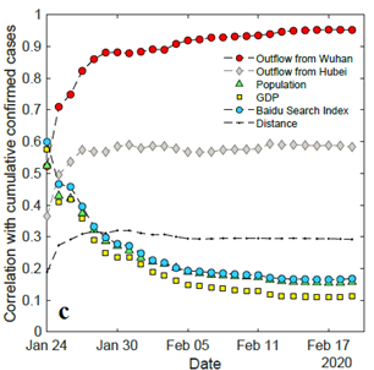Prof. Jia Jianmin’s Research on COVID-19 Epidemic Published in Nature.
Prof. Jia Jianmin’s research “Population Flow Drives Spatio-Temporal Distribution of COVID-19 in China” was published in Nature on April 29 (UTC+8). He is the corresponding author for this research article, teamed with researchers from the University of Hong Kong, Yale University, and other Chinese universities. The research develops a population-flow-based “risk source” model to track population flows that policymakers worldwide can use to more effectively assess risk and allocate limited resources while combatting the COVID-19 epidemic.
Different from existing epidemiological models, this model exploits mobility data on population flows, which includes phone data or other big data sources that can quantify the movement of people. This work shows that it is possible to very accurately forecast the timing, intensity, and geographic distribution of the COVID-19 spread based on population movement alone. Moreover, by tracking population flows to different locals, the model can provide policymakers and epidemiologists a powerful tool to limit an epidemic’s impact and save lives.
In developing the model, the researchers used anonymous and aggregated nationwide mobile-phone geo-location data to track about 11.5 million occasions of people transiting through Wuhan between Jan. 1 and Jan. 24, 2020--a period covering the run-up to the Chinese Lunar New Year and the annual chunyun mass migration in China. People moved through Wuhan to 296 prefectures in 31 provinces and regions throughout the country. The researchers linked the population-flow data to COVID-19 infection counts by location and time at the prefecture level. The researchers found that the distribution of people leaving Wuhan accurately predicted the relatively frequency of COVID-19 infections across China through Feb. 19, 2020. Moreover, they developed a “risk source” model that leveraged the population flow data to accurately forecast confirmed cases and identify locales at risk of high transmission rates during the outbreak’s early stages.
The population outflow from Wuhan provides a benchmark to evaluate transmission risks nationwide. The hazards model yields a benchmark trend to identify which locales deviate significantly (90% confidence interval), and develops an index for assessing COVID-19 community transmission risk over time for different locations. This approach can be used by policymakers in any nation with available data to make rapid and accurate risk assessments and to plan allocation of limited resources ahead of ongoing outbreaks.

The research finds out that the quarantine of Wuhan and Hubei province were generally successful in limiting the virus spread in most locales, and especially the outflow of Wuhan population to other non-Wuhan Hubei cities is three times than that of the population outflow to other prefectures nationwide. According to the dynamic model developed by the researchers, the outflow population from Hubei (excluding Wuhan) had no additional significant effect on confirmed cases over time across locales. Therefore, the effect of population outflow from non-Wuhan Hubei prefectures on COVID-19 spread is much more limited. In addition, the high predictive power of the model is based on the effectiveness of public health measures nationwide, so that the number of infected people was uniformly distributed in the population outflowing from Wuhan into different prefectures across the country as predicted by the model while most transmissions were within family clusters (83%). Overall, the research shows COVID-19 spread outside Wuhan exhibits high spatio-temporal pattern, which is a result of strict public health measures.
The risk source model developed in this paper can be applied using any dataset that accurately captures people’s movements, such as train ticketing or car tolling data, the researchers noted, meaning that policymakers worldwide could use it to foresee the virus’s spread. “People spread contagious diseases when they travel,” said Nicholas Christakis, director of the Yale Institute for Network Science. “By accurately capturing population movements over time, we can predict how a contagion will spread geographically and use data-analytic techniques to control it before a devastating epidemic erupts or re-erupts.”
Since the Spring Festival holiday, the research team led by Prof. Jia Jianmin have devoted to the policy research on tackling COVID-19 initiated by the National Natural Science Foundation of China (NSFC). During the outbreak’s early stage, the research team provided several policy reports to different levels of governments regarding the COVID-19 spread risk based on population flow data.
Prof. Jia Jianmin is the corresponding author of this research. The study’s co-authors are Jayson S. Jia, The University of Hong Kong; Lu Xin, National University of Defense Technology; Yuan Yun, Southwest Jiaotong University; Xu Ge, Hunan University of Technology and Business; and Nicholas A. Christakis, Yale University.
About Prof. Jia Jianmin

Prof. Jia Jianmin is the Presidential Chair Professor at CUHK-Shenzhen. He was a Professor and Chairman in Department of Marketing at The Chinese University of Hong Kong, and Dean of School of Economics and Management, Southwest Jiaotong University. Prof. Jia served as a member of the National MBA Education Supervisory Committee of China, a member of the Expert Consultation Committee of the Management Sciences Department of the Natural Science Foundation of China, an Academic Trustee of Marketing Science Institute (USA), and an Associate Editor of Operations Research. In 2019, Prof. Jia was awarded the “Fudan Prize for Eminent Contributions to Management Science”.




